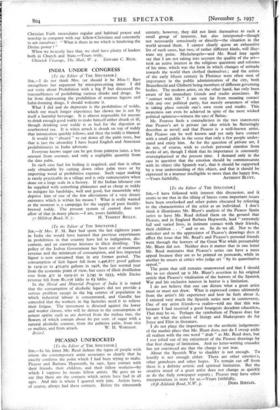PICASSO UNFROCKED [To the Editor of THE SPECTATOR.]
SIR,—In his letter Mr. Read defines the types of people with whom the contemporary artist associates so clearly that he exactly confirms the point which I had been trying to make. Picasso and Barbara Hepworth, he says, have contact with their friends, their children, and their fellow workers—by which I suppose he means fellow artists. He goes on to say that these are the contacts which artists have had in all ages. And this is where I quarrel with him. Artists have, of course, always had these contacts. Before the nineteenth century, however, they did not limit themselves to such a small group of interests, , but also interpreted—though' not necessarily consciously or directly—the situation in the world around them. I cannot clearly quOte an exhaustive list of such cases, but two; of rather different kinds, will illus.. trate my point. Michelangelo—and Mr. Read may again say that I am not taking into account the quality of the art— took an active interest in the religious questions and reforms of his time, which was the form in which changes of attitude towards the world then clothed themselves ; and the artists of the early fifteen century in Florence were often men of importance in the public administration Of the city, both Brunelleschi and Ghiberti being members of different governing bodies. The modem artist, on the other hand, has only been aware of his immediate friends and studio associates. By " contact with life " I am very far from meaning contact with any one political party, but merely awareness of what is taking place outside one's own room and studio. This awareness can even be achieved in spite of the most wicked political opinions—witness the case of Balzac.
Mr. Penrose finds a contradiction in the two statements that Picasso's art is private (an idea which he flatteringly describes as novel) and that Picasso is a well-known artist.
But Picasso can be well known and yet only have contact with a small public in the sense that only a few people under- stand and enjoy him. As for the question of private art, I do not, of course, wish to exclude personal emotion from works of art, though I think that its importance is constantly overemphasised at the present time. I demand only in the case in question that the emotion should be commensurate with its object (the Spanish war), that it should be supported by a true understanding of this object, and that it should be expressed in a manner intelligible to more than the happy few.














































 Previous page
Previous page